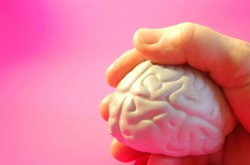Gadfly | September 9th, 2015

The obituary of Dr. Oliver Sacks, 82, who died on August 30, appeared on the front pages of national newspapers, with a photo of him holding a three-pound human brain in one hand.
That brain has over one trillion cells, with a 100 billion of them acting as neurons linking up millions of networks that give us intelligence, creativity, emotion, consciousness, and memory. If the wrinkles in the cortex could be ironed out, it would cover a very large office desk.
Known as the poet laureate of medicine, He published millions of words. As Norman Dodge of The Globe And Mail wrote: “Oliver Sacks is our greatest chronicler of people with unusual neurological and sensory disabilities and experiences, and of the remarkable adaptations that people have made.”
He has been entertaining me for years with real stories such as the man who thought his wife was a hat.
Sacks knew he was going to die early no matter what. He had lost an eye due to melanoma of the retina which then metastasized to his liver and other organs.
He was born of the union of two English doctors who also had three older sons. One of his brothers is schizophrenic and two are doctors.
He knew in adolescence he was gay. We must remember he was born when homosexuality was a criminal offense in England.
One morning his father asked him whether he liked girls. He said, “they’re all right.” His father then asked: “Perhaps you like boys better?” Sacks replied; “Yes, I do. Don’t tell Ma.” The next morning his mother told him: “You are an abomination. I wish you had never been born.” She didn’t talk to him for days, and never had a serious discussion with him after that morning.
Many years later Sacks wrote: “We are all creatures of our upbringings, our cultures, our times…My mother did not mean to be cruel, to wish me dead….But her words haunted me for much of my life and played a major role in inhibiting and injecting with guilt what should have been a free and joyous expression of sexuality.” Early on he decided to live “a certain distance from life,” but unexpectedly fell in love with Bill Hayes at age 77. Such love changed his life and “the habits of a lifetime, like the decades of meals of cereal or sardines eaten in 30 seconds standing up.”
A scientist who examined the fathomless mysteries of the brain with voracious curiosity
Sacks was an Oxford University-trained scientific and medical genius who once flunked an anatomy course in med school, held a weight-lifting championship in California, was a member of the Hells Angel motorcycle gang and served as their informal medical advisor, was a drug addict for four years before curing himself, explored LSD, was an avowed atheist, and ended his life as chairman of the Neurology Department at the New York University School of Medicine.
In the middle of his career he received about 10,000 letters a year from patients and people requesting help.
Sacks loved to handle the mysteries of the brain and wrote hundreds of case studies of people who had unusual and profound problems—such as the man who could remember what he did in the past for only seven seconds.
I like to use the example of the four-year-old son of a concert pianist who was listening to his mother practice a Beethoven sonata for her next concert.
She couldn’t get one part, so took a break to the kitchen to get a cup of tea. While there, she heard the sonata being played perfectly. Rushing back to the room in shock, she saw her autistic son playing the piano---for the first time. Even at age 40 he couldn’t brush his teeth or dress himself, but he proved to be a mathematical and memory genius. He memorizes city phone books for fun. Once in a large city he shocked a waitress by reciting her telephone number. He had spent the night before memorizing the city’s phone book and her name was on her uniform. He has numerous “savant” talents. He can read one page of a book with one eye—and the other page with his other eye at the same time. His brain then assimilates the information in one place. But the real strange thing is he can do the same thing when the book is upside down!
Why do we give so many tests to kids when we don’t even understand how the brain functions? For doubters, I suggest a book by Darold A. Treffert titled Islands of Genius/ The Bountiful Mind of the Autistic, Acquired, and Sudden Savant. The case studies will blow your mind—I mean, brain.
When my wife Corky had a stroke about five years ago she was reading a book. All of a sudden all of the words on the right-side page disappeared. When she turned the page, the other side was blank, too. We knew then there was trouble in river city. After her hospitalization and treatment the words returned to the pages and she again is an avid reader.
Some Brain Neurons Go Snap, Crackle, And Pop—While Others Just Fizzle And Sizzle
Spencer Nadler, a pathologist who specializes in analyzing brain diseases, describes the brain this way: “Envision your brain, its billions of impulsive neurons, tendrils entwined, connected up in electrical circuits, elaborate glial scaffolds shoring up these circuits, like electrical tape. In the synapses, fluid filled clefts that separate neuron s from one another, electrical impulses convert to chemical ones. Brain chemicals seep through the cleft fluid, bridging it with a flow of molecules. Thus do we smile, or weep, plumb the ocean or fiddle a tune.”
One of Sacks’ patients, a painter who used many colors, was injured in an accident which left him seeing things only in black and white. A few of his connections had fizzled and sizzled. Sacks wrote: “He would glare at an orange in state of rage, trying to force it to resume its true color…..He would stare at a gray lawn trying to see it green. He found himself in an impoverished world but in an alien, incoherent, and almost nightmarish one.” The painter later painted pictures in black and white.
Sacks himself had an unusual medical history after he had a mountaineering accident. It left him with the sensation that his left leg was no longer attached to his body. Another electrical breaker in his brain had opened for awhile.
Sacks had another mystifying congenital neuron condition that about two percent of the population has. He suffers from prosopagnosia, a neurological defect which prevents him from recognizing people from their facial characteristics. He can recognize his neighbor’s dogs but he cannot recognize his neighbors.
Sacks once apologized for running into a large bearded man in a room. He was looking at himself in a mirror.
A stranger greeted him by name meeting him on the street. Sacks later found out it was his psychiatrist he had been seeing twice a week for years.
He can recognize people by the glasses they wear or the color of the hair—but he can’t recognize faces.
With all of these complexities of the 100 trillion brain cells, can you imagine giving a student a standardized test to see whether he should advance to the next grade? Absolute folly—and should be considered a crime. There is nothing “standard” about people.
We have relatively little knowledge of the ultimate powers of our brains
Sacks certainly has had some of the most fascinating patients in the world. Canadian novelist Howard Engel woke up one morning and discovered he was unable to recognize the words in his daily newspaper. He thought the language looked like Russian. He asked his wife to check the paper. She read several paragraphs to him—in English. He had suffered a stroke during the night.
Howard taught himself to read again by tracing words with his fingers and moving his tongue. In the neurological trade it is known as “metamodel sensory motor alchemy.” It is strengthening a part of the brain that has had nothing to do with reading.
Another patient woke up paralyzed and decided to prove she could still think. She memorized the entire New York Times crossword puzzle (by the end of the week they are tough!), its configuration, and all of its clues in the morning. Later in the day, in a single herculean attempt, she solved the whole puzzle.
Sacks wrote of the case of the blind Zoltan Torey, an Australian psychologist, who expanded his “mental eye” by freeing up his visual cortex by memory. He not only climbed ladders to fix his roof gutters on his house, when he went for walks with his seeing friends, he “saw” more than they did because of his well-developed, tremendous “visual” memory.
Sacks also had twin savants as patients who couldn’t take care of the most mundane daily tasks like bathing and brushing teeth, but could rattle off numerical tricks such as memorizing 300-digit numbers or 20-digit prime numbers. Boy, could they score on math tests!
The sounds of music in the brain
The entire Sacks family enjoyed and participated in music by singing and playing instruments in classical and popular renditions. Consequently, I think his book Musicophilia: Tales of Music and the Brain is the most fascinating of all of his works.
We understand the development of language. We do learn to communicate somehow. But the development of music is harder to understand. We don’t need it to communicate. Charles Darwin in his Descent of Man wrote this: “As neither the enjoyment or the capacity of producing musical notes are faculties of the least use to man…they must rank among the most mysterious with which he is endowed.”
Sorry, Charlie, not true. Let’s get to the gritty first with the story of Dr. Tony Cicoria, a 42-year-old orthopedic surgeon and former football player without much interest in music. The doctor was standing at a pay phone in 1994 at a New York lakeside pavilion when he was struck by lightning. His first reaction was: ‘Oh, shit, I’m dead.” He had severe burns on his face and his left foot where the electrical charge had entered and left his body.
It took him a couple of weeks to recover and to discover all of his surgical skills were intact. But he had acquired another pastime—an insatiable desire to listen and play piano music. He had had a few piano lessons as a child but had given it up over 30 years ago. He soon ordered piano music, recordings, and bought a piano. Three months after being struck he was absolutely possessed by music. He would get up at four a.m. to practice the piano until he left for the hospital. His evenings were spent at the piano. His wife divorced him because of it--but music continued to dominate his life.
There are dozens of similar case studies in the book. It’s a great read.
Another great read is The Man Who Mistook His Wife for a Hat, who perhaps is Sacks’ most famous patient. After a session in Sacks’ office, the patient tried to find his hat. He reached out with his hand and took hold of his wife’s head, tried to lift it off--- to put it on. He had mistaken his wife for a hat. She was not amused---or surprised.
January 5th 2026
December 29th 2025
December 29th 2025
December 29th 2025
December 9th 2025
_(1)_(1)_(1)__293px-wide.jpg)

__293px-wide.jpg)
__293px-wide.jpg)
_(1)__293px-wide.jpg)
__293px-wide.jpg)